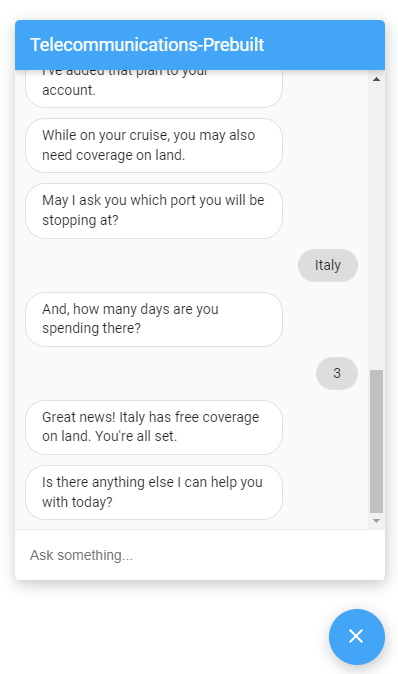The final step of this tutorial is to host your Dialogflow agent. App Engine is used for hosting, because it is simple to set up and scales well. The Dialogflow Messenger integration is used for an agent user interface.
Project configuration
Ideally, your Dialogflow agent and the App Engine instance are both in the same project. Also, you must enable the Cloud Build API.
Before creating the instance, select your project from the Google Cloud console.
Enable the Cloud Build API for the project.
Environment setup
You need to install and configure some things in order to develop a Go application for App Engine. Follow any steps you haven't already completed at Setting up your development environment.
Create the web service code
The example code for this tutorial is written in Go, but you can use any language supported by App Engine. Create the following file structure anywhere on your local machine:
go-app/: directory for your Go service.templates/: directory for your Go HTML templates.index.html: Go HTML template.
app.yaml: Your service's configuration settings.main.go: Your application code.
The next three sections provide content for the three files.
Contents of the index.html file
This Go HTML template file contains the HTML for the homepage. Populate this file with the following contents:
<!DOCTYPE html> <html lang="en-US"> <head> <meta charset="utf-8"> <meta name="viewport" content="width=device-width"> <title>Tutorial agent</title> </head> <body> <p>Open the chat window in the bottom right corner.</p> </body> </html>
Contents of the app.yaml file
This is a configuration file which specifies your service's runtime environment settings. You can reference the Go 1.12+ Runtime Environment document to see the list of supported Go versions. Populate this file with the following contents:
runtime: go116 # or another supported version
Contents of the main.go file
This file contains your application code. Populate this file with the following contents:
// Package main is the main package package main import ( "log" "net/http" "os" "text/template" ) var templates *template.Template func init() { templates = template.Must(template.New("").ParseGlob("templates/*")) } // indexHandler handles the homepage. func indexHandler(w http.ResponseWriter, r *http.Request) { if r.URL.Path != "/" { http.NotFound(w, r) return } if err := templates.ExecuteTemplate(w, "index.html", nil); err != nil { log.Fatal(err) } } func main() { // Register the handlers http.HandleFunc("/", indexHandler) port := os.Getenv("PORT") if port == "" { port = "8080" log.Printf("Defaulting to port %s", port) } log.Printf("Listening on port %s", port) if err := http.ListenAndServe(":"+port, nil); err != nil { log.Fatal(err) } }
Deploy your web service
Your code is now ready to deploy. These steps use the gcloud tool for deployment:
Ensure that gcloud is configured with the same project as your Dialogflow agent. To check the project:
gcloud config get-value project
To change the project:
gcloud config set project YOUR_PROJECT
In your
go-appdirectory where yourapp.yamlfile is located, deploy your web service to App Engine using the following command:gcloud app deploy
The command will prompt you for a region. Be sure to select the same region as your Dialogflow agent. The command will output the
target urlvalue, which is the URL for your web service.To launch your browser and view your web service, you can open the target URL from the previous step, or run the following command:
gcloud app browse
Setup Dialogflow Messenger
To set up unauthenticated access to your Dialogflow CX Messenger agent:
- Go to the Dialogflow CX console.
- Choose your Google Cloud project.
- Select your agent.
- Select the Manage tab.
- Click Integrations in the left sidebar menu.
- Click Connect on Dialogflow CX Messenger.
- A configuration dialog opens.
- If the integration was previously setup for this agent, you will see embeddable HTML code. Regardless of whether you want what authenticated or unauthenticated, click the Disable... button at the bottom of the dialog, so you can reconfigure the settings in the next step.
- Select an Environment.
- Select Unauthenticated API.
- Select a style.
- Optionally restrict domain access.
- Click Enable the unauthenticated API.
- The dialog will show the embeddable HTML code that can be embedded on your website. Copy this code.
- Click Done.
Embed the agent in your web service
Paste the embed code you copied above in your index.html file.
The <script> and <df-messenger> HTML elements
should be in the <body> element of your page.
Deploy your web service app again with gcloud. Once deployed, you can interact with your agent through the webpage by clicking the chat icon in the lower right corner.

You now have a fully deployed Dialogflow agent! Try having a conversation with the agent.
Cleanup
While going through the steps of this tutorial, you created billable resources. To avoid incurring additional charges to your Google Cloud account:
- Delete your database instance.
Delete your function:
gcloud functions delete tutorial-telecommunications-webhook
More information
For more information about the steps above, see:
